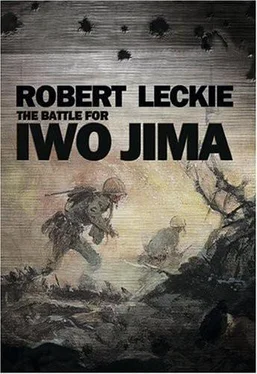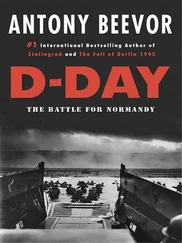Sometimes, though, the Japanese soldiers were in something of a hurry to enter Yasakuni. They had been taught that the Marines were brutal and cruel men who would torture them if they were taken alive. Also, to be taken prisoner was considered disgraceful. Japanese soldiers taken captive against their will or while they were unconscious often pleaded for knives to kill themselves, because, as they explained, they could no longer face their families.
Therefore, whenever the battle began to go against the Japanese, their soldiers began to commit suicide either in order to escape torture or to avoid capture. That certainly did not help the Japanese commander, especially one like Kuribayashi, who had ordered his men “to defend Iwo Jima to the bitter end.” It was helpful to the Marines, though.
That night Colonel Liversedge looked grimly at the crater looming darkly above him and said to his officers:
“At dawn we start climbing.”
At dawn of February 23, the Americans went up to the top of Suribachi with surprising ease. A patrol consisting of Sergeant Sherman Watson and Privates First Class Ted White, George Mercer and Louis Charlo climbed to the summit without seeing a single enemy soldier. Unknown to them, the surviving Japanese were sitting silently within their caves and caverns.
The patrol returned and reported that the summit of the volcano was undefended. Hearing this, Lieutenant Colonel Chandler Johnson decided to capture it. Colonel Johnson was a stern, pudgy man who impressed his men by roaming the battlefield in full view of the enemy. He didn’t wear a helmet and his only weapon was a pistol stuck carelessly in his back pocket. On this momentous Friday morning, Colonel Johnson quickly rounded up a 40-man platoon. Most of the Marines in it had been in Lieutenant Wells’s platoon. But Wells had been wounded, and now Lieutenant Harold Schrier was in charge.
“If you reach the top,” Johnson said to Schrier, “secure and hold it.” He handed the lieutenant a square of colored cloth. “And take this along,” he said. The cloth was an American flag. It had been brought ashore from the transport Missoula.
Schrier’s men began to climb the northern, or inner, slope of Suribachi. Below them, word spread quickly that an attempt was being made to take the high ground that had been such a cruel thorn in the Americans’ side. Many Marines paused to watch the patrol’s wary ascent. Many men of the invasion fleet were also watching through binoculars.
Tension seemed to mount with each step of that halting ascent. Climbing gingerly, Schrier’s men picked their way through the debris of wrecked enemy positions. They could hear the sounds of battle behind them, but up on Suribachi there was only an eerie silence. A half hour after they began to climb, they reached the rim of the crater. They halted. Still silence. Schrier looked around. He could see a few battered enemy emplacements and a few cave entrances. But no Japanese. Silently the lieutenant motioned his men over the rim.
One by one they filed into the crater, fanning out to take up positions just inside it. Still silence…. One of the Marines tried to provoke the enemy with an insulting gesture. But there was no response. Then, suddenly, a Japanese soldier began climbing out of a deep hole. Corporal Harold Keller fired three times from the hip and the Japanese soldier dropped out of sight. Then hand grenades came flying out of nearby caves. The Marines took cover in the shadows and replied with grenades of their own.
While they did, Corporal Robert Leader and Private First Class Leo Rozek found a flagpole. It was a length of pipe, apparently the remains of a rain-catching system. The flag was affixed to the pipe, which was jammed between rocks, and then Schrier, with Sergeants Henry Hansen and Ernest Thomas, Corporal Charles Lindberg and Private First Class James Michels, raised Old Glory over Iwo Jima. The event was photographed by Sergeant Louis Lowery while Private First Class James Robeson, who refused to get in the picture, stood guard and jeered, “Hollywood Marines!” Thus, at ten-thirty in the morning of February 23, 1945, the Stars and Stripes were flung to the winds whipping over Suribachi.
“There goes the flag!” cried jubilant Marines below. Cheers rose all over the northern end of the island. Some Marines wept in their foxholes. Out on the water the ships of the fleet tootled their whistles in salute. Hospital ships broadcast the news that Suribachi had fallen. For the first time in the war, Japanese soil had been captured by Americans. And when that thrilling small speck of red-white-and-blue broke into view above the gaunt crest of the volcano, even Secretary of the Navy James Forrestal was at hand to see it.
The Secretary had insisted upon coming ashore from the flagship, Eldorado. He was standing beside General Holland M. Smith when he saw the symbol of Suribachi’s fall. He turned to the general to say: “Holland, the raising of that flag means a Marine Corps for the next 500 years.”
On the summit itself, the Japanese had begun to challenge that flag. A rifleman stepped out of a cave and fired at Robeson, who shot him dead with a long burst from his BAR (Browning Automatic Rifle). Then an enemy officer charged out, brandishing a broken sword. A volley of rifle fire tumbled him into the crater. Moving swiftly, the Marines used flame throwers and demolition charges to seal off the summit’s caves. Soon other platoons joined them to help mop up the crater.
At the volcano’s base, Colonel Johnson became concerned for his now-famous flag. As he well knew, United States Marines are notorious souvenir hunters. “Some son of a gun is going to want that flag,” he said to his adjutant, “but he’s not going to get it. That’s our flag. Better find another one and get it up there, and bring back ours.”
So a runner went looking for a flag. He found a fairly new one, nearly twice as large, aboard Landing Ship 779. As he brought it back to Suribachi, he was accompanied by an Associated Press photographer named Joe Rosenthal.
Rosenthal came panting to the summit of Suribachi in time to photograph the second flag raising. Heaping stones to achieve height, the diminutive Rosenthal hopped up on the pile to take the most famous picture of World War Two. By coincidence, by accident and in haste, he had made the greatest battle photograph of American arms.
Six men helped to put up the second flag. They were: Privates First Class Ira Hayes, Franklin Sousley and Rene Gagnon, Sergeant Michael Strank, Corpsman John Bradley and Corporal Harlon Block. Three of them—Strank, Block and Sousley—were later killed. Bradley was wounded. And of the men who put up the first flag, Sergeants Hansen and Thomas and Private First Class Charlo eventually died on Iwo. Robeson and Michels were wounded.
Thus, five days after the Marines had landed, through valor, sacrifice and in suffering, the United States flag came to fly at Iwo Jima.
Chapter 5
THE UP-ISLAND DRIVE
The capture of Mount Suribachi signaled only the beginning of the battle for Iwo Jima. On Tuesday, the second day of fighting, when Harry the Horse and his 28 Marines had wheeled south against the volcano, the rest of the 5 Division, together with the entire 4, had faced north for the up-island drive to victory.
It was a nightmare battle. No less than 23 of the men participating would later be awarded the Medal of Honor. In all, the astonishing total of 26 was earned by valor displayed during the fighting on Iwo Jima. One of these was earned by 17-year-old Private First Class Jacklyn Lucas. Standing only 5 feet 8 inches, but weighing 200 pounds, Lucas was a young bull. He was also a “deserter.” Eager to see combat, tired of tame duty in a quartermaster shed, he had “joined” the 5 Division by simply going aboard ship when that outfit left Hawaii.
Читать дальше











